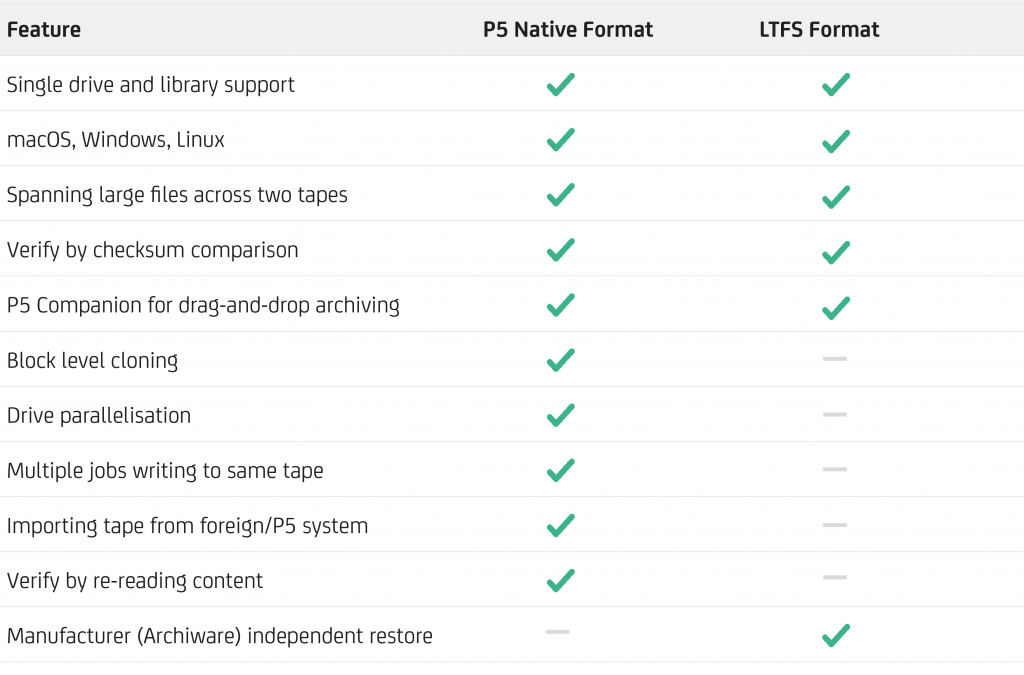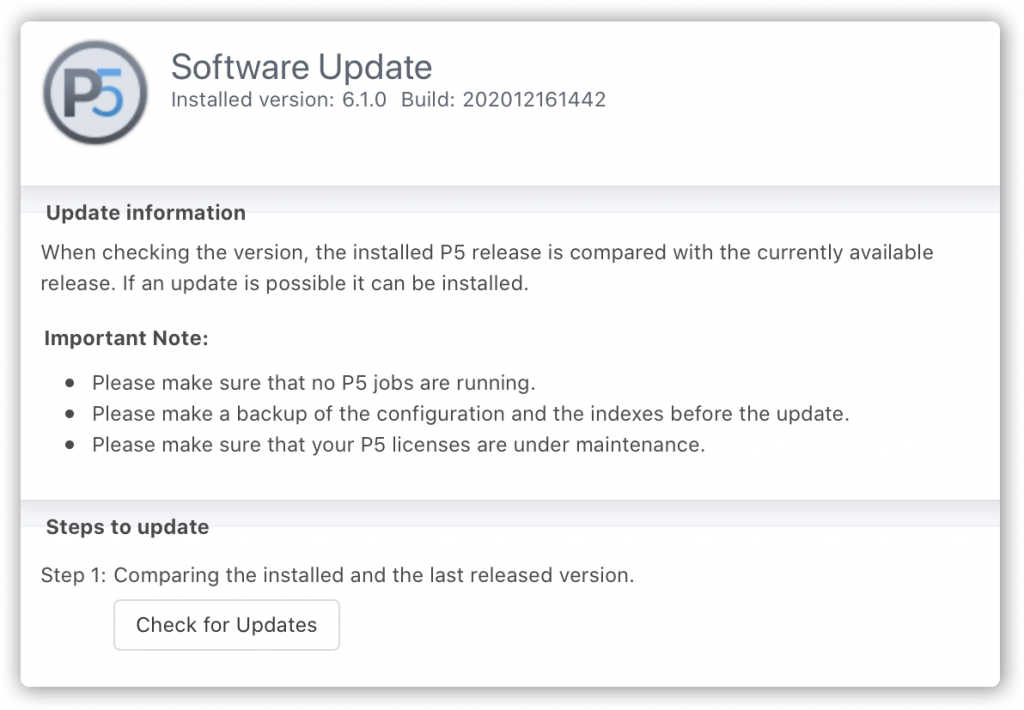

By David Fox
Introduction
On January 26th, Archiware GmbH, expert in data backup and archiving, released the latest version 6.1 of its P5 Data Management Platform. There’s plenty of new functionality between version 6.0 and 6.1, so let’s take a look at all that’s new in this release.
P5 Archive
Archiware introduces Enhanced LTFS support with P5 Archive
Archiware P5 has always strived for broad support across many different types of storage, giving customers great flexibility so they can choose where their data is stored. With this new release, the vendor-neutral LTFS tape format is added to P5 Archive module. This means the familiar archive workflow, with indexing of data and capture of previews and metadata, now works with either LTFS tapes or the traditional Archiware proprietary tape volume format.
To achieve this, Archiware have implemented an entirely new cross-platform LTFS driver that avoids the use of the user-space filesystem (FUSE) drivers that are typically used by competing products. This new driver is fully ISO/IEC compliant and allows the entire P5 Archive workflow to operate seamlessly while writing to an LTFS pool of tapes.
Users wishing to archive data to tape can now choose between two different tape formats when creating a storage pool:
- P5 volume format – supported for 20 years across thousands of P5 installations, compatibility across all P5 supported platforms, support for block-level cloning, parallel writing across multiple tape drives, data-compression/encryption and free from character set limitations for file/folder names.
- LTFS volume format – Open standard (ISO/IEC 20919:2016) and manufacturer-independent tape format, compatible across all P5 supported platforms (macOS, Windows, Linux, FreeBSD) and also with other LTFS software tools for software-independent restore of data.
Volumes can be formatted as LTFS by labelling, in single drives or libraries. Existing native pools and LTO volumes will continue to work in combination with LTFS volumes.
P5 Volume format continues to be the recommended option for P5 Archive workflows. LTFS is a useful option where interoperability with non-Archiware systems is required.

Note: The LTFS Import/Export feature, which is independent of the new LTFS Archive functionality described above, is supported only on macOS and Linux in the 6.1.0 release, as was the case in the 6.0 release.
The table below summarises the differences between the P5 volume format and the new LTFS volume format.

Updated P5 Companion App
The desktop application for macOS, Windows and Linux is updated to support archiving of individual files, selectable archive plan from drop-down menu, and various UI tweaks to make it easier to use.
For users of the P5 Archive App (now discontinued), the P5 Companion now supports stub files created by this application and can restore them.

Poster-frame thumbnail when creating video previews
P5 Archive will now automatically capture a poster-frame when archiving video files, using FFmpeg. The poster frame will be displayed in the grid/thumbnail view and upon double-clicking, the video proxy itself can be played back.
Built-in FFmpeg and ImageMagick open-source tools
A P5 installation now includes both of these tools for creation of video and graphic previews, manual download and installation of these open-source tools is no longer required. If a custom installation is required, including plug-ins or extensions, an external installation can be performed and used by P5.
P5 Sync:
Merge multiple source folders into one destination folder
For ease of organising the layout of multiple source folders copied to a single target directory within a single Sync plan. It’s now possible to specify how much of the original source path is created in the target directory, by including a dot in the source path. Creating multiple Sync plans to achieve this is no longer required.
The default behaviour doesn’t change, which is to append the entire source path at the target location. For example, take these two data folders:
/storage_1/path/data_A
/storage_2/path/data_B
If we sync both to the target destination folder:
/target_folder
We would see these two folders created at the destination:
/target_folder/storage_1/path/data_A /target_folder/storage_2/path/data_B
In 6.1, the inclusion of a dot in the path gives more explicit control. For example if we modify the source folders in the sync plan (not on the filesystem) as follows and sync to the same location:
/storage_1/path/./data_A
/storage_2/path/./data_B
Then we would see these folders created at the destination. The path elements before the dot are excluded at the destination:
/target_folder/data_A /target_folder/data_B
This advanced option could be used with care to avoid directories ‘colliding’ at the target. Source paths with and without dots can be combined within the same sync plan if needed.
Checksum verification
A crucial feature for media customers who require maximum data security and accuracy, a checksum is automatically created while reading each file from the source, and also whilst writing to the destination. These are verified to match. The checksum is also stored as an extended attribute within the destination file, for interrogation by other workflow tools, if needed.
For example (via Linux command-line), below we list attributes attached to a JPG file and then output the contents of the attribute into which the SHA256 checksum has been written.
> attr -l DSC02870.jpg Attribute "com.archiware.p5.dfcsum.sha256" has a 64 byte value for DSC02870.jpg > attr -g com.archiware.p5.dfcsum.sha256 DSC02870.jpg Attribute "com.archiware.p5.dfcsum.sha256" had a 64 byte value for DSC02870.jpg: 0881b3a5ef94aa678f9f9069e47e6812d6920744d0a47ce94c1f554159d0d0f2
Additional P5 Features
Updating P5 in the browser
P5 software updates can now be installed directly from the web-admin interface on macOS and Linux installations. This is particularly useful for remote systems, such as Amazon EC2 instances, where updating can be complex. A simple click checks for newer versions on Archiware’s servers, downloads and installs and restarts.

This update feature is provided only for platforms that do not maintain their own software registry that includes P5. Both Windows and NAS systems such as QNAP, Synology and ReadyNAS include their own package manager.
Media management: Optimized volume management for cloud storage
Storage management of the staging areas has been optimized, the storage size of the staging area can be considerably smaller, since the chunks necessary for the restore are deleted immediately after use.

Download Archiware P5 as an update or free 30-day trial under: https://p5.archiware.com/download
If you have any questions regarding the new version, please do not hesitate to contact our support team. For questions regarding licensing, please contact sales@archiware.com.
